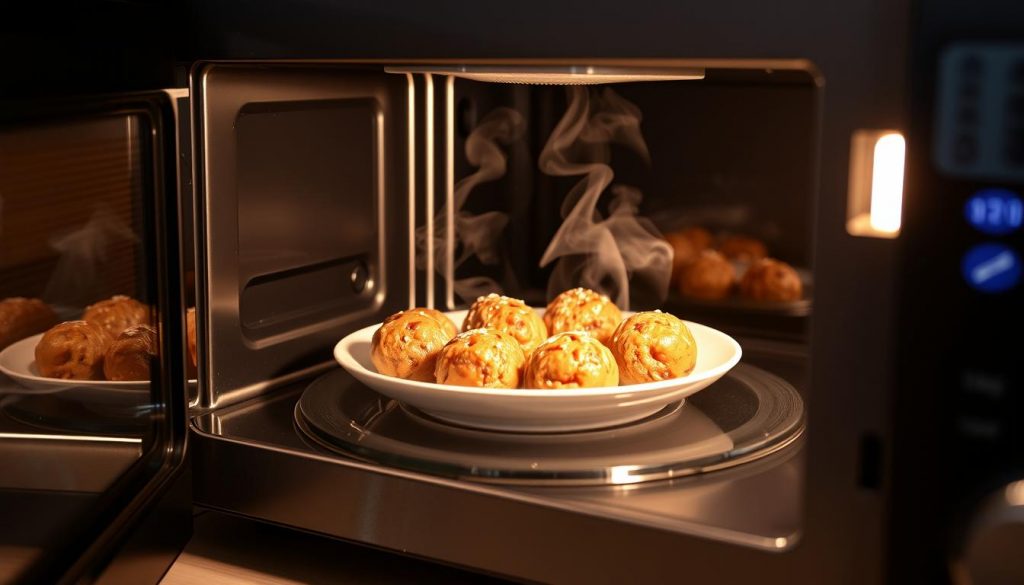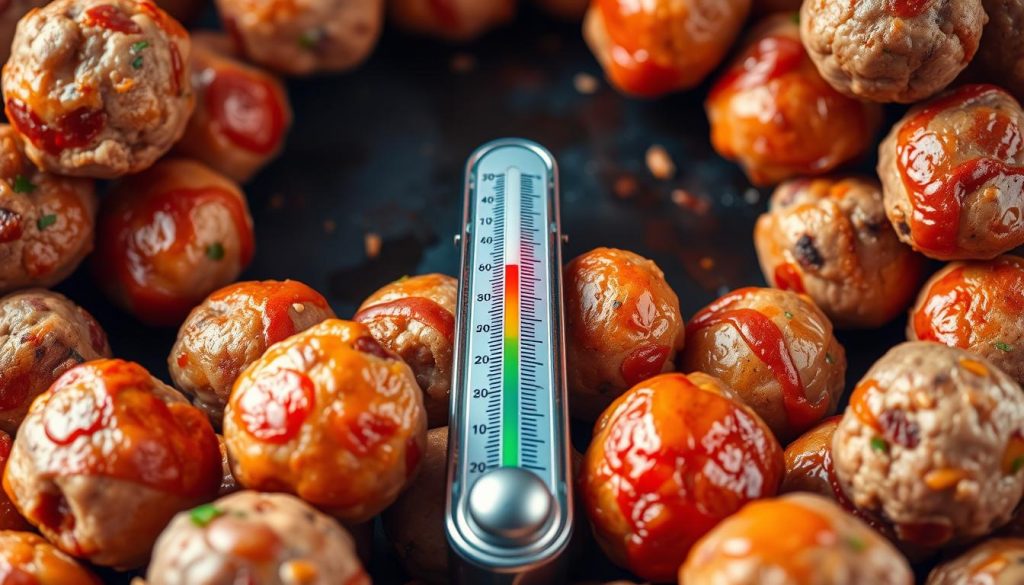Meatballs are delicious, but sometimes we can’t eat them all at once. Proper storage is crucial for leftover meatballs. Let’s explore how to keep your meatballs safe and tasty in the fridge.
Knowing how to store meatballs correctly can prevent food safety issues. We’ll discuss proper storage techniques and how to tell if meatballs have gone bad.
Key Takeaways
- Proper refrigeration is crucial for meatball safety
- Cooked meatballs can last 3-4 days in the fridge
- Use airtight containers for best storage results
- Check for signs of spoilage before eating leftovers
- Freezing can extend meatball shelf life significantly
Understanding Meatball Storage Basics
Proper storage keeps meatballs fresh and safe to eat. Let’s explore how to make the most of your tasty leftovers. These tips will help you enjoy your meatballs longer.
Proper Storage Temperature Requirements
Your fridge temperature is crucial for preserving meatballs. Keep it below 40°F (4°C) to slow bacterial growth. This extends the shelf life of cooked meatballs to 3-4 days when stored right.
Ideal Container Types for Meatball Storage
Pick the right containers to keep meatballs fresh. Shallow, airtight containers work best for quick cooling. They also prevent moisture buildup. Glass or BPA-free plastic containers are great for fridge storage.
Air-Tight Packaging Methods
Use air-tight packaging to maintain freshness. Wrap meatballs tightly in plastic wrap or foil before containerizing. This extra layer prevents freezer burn and keeps meatballs moist.
| Storage Method | Maximum Storage Time | Best Practices |
|---|---|---|
| Refrigeration | 3-4 days | Use airtight containers, keep below 40°F |
| Freezing | 2-3 months | Freeze on baking sheet first, then transfer to freezer bags |
| Room Temperature | 2 hours | Not recommended for long-term storage |
Follow these storage basics to keep meatballs fresh and tasty longer. Good storage preserves flavor and protects against foodborne illnesses. Enjoy your meatballs safely!
How Long Does Cooked Meatballs Last in the Fridge
Meatball shelf life is key for safe eating. We’ve done the research to give you accurate info on refrigerated meatballs. Let’s explore how long they last and how to store them properly.
Cooked meatballs last 3-4 days in the fridge when stored right. This applies to homemade and store-bought types. Refrigerate meatballs within two hours of cooking to stop bacteria growth.
Here’s a breakdown of refrigerated meatball shelf life:
| Storage Method | Refrigerator Temperature | Shelf Life |
|---|---|---|
| Airtight container | 40°F (4°C) or below | 3-4 days |
| Vacuum-sealed | 40°F (4°C) or below | 4-5 days |
| Sauce-covered | 40°F (4°C) or below | 3-4 days |
These are general guidelines. Actual expiration may vary based on ingredients, prep method, and storage. Trust your senses to judge if meatballs are still good to eat.
“When in doubt, throw it out. It’s better to be safe than sorry when it comes to food safety,” advises culinary expert Chef Maria Rodriguez.
For longer shelf life, store cooked meatballs in shallow airtight containers or freezer bags. This keeps them fresh and prevents mixing with other foods in your fridge.
Signs of Spoilage in Stored Meatballs
Spotting food spoilage is key for safe eating. Let’s look at signs that show your meatballs have gone bad.
Visual Indicators of Spoiled Meatballs
Mold is often the first visible sign. It looks like fuzzy spots in various colors. White, green, or black patches mean it’s time to toss the meatballs.
Smell and Texture Changes
Bad meat has a distinct odor. A sour or unpleasant smell is a warning sign. The texture might become slimy or sticky.
These changes point to bacterial growth and food spoilage.
Color Variations to Watch For
Fresh meatballs have a consistent color. Gray, brown, or greenish hues mean it’s time to discard them. These color shifts often show bacterial growth.
| Spoilage Sign | Description | Action |
|---|---|---|
| Mold | Fuzzy spots in white, green, or black | Discard immediately |
| Odor | Sour or unpleasant smell | Do not consume |
| Texture | Slimy or sticky | Throw away |
| Color | Gray, brown, or greenish hues | Dispose of safely |
If you’re unsure, it’s safer to toss it out. Eating spoiled meatballs can make you sick. It’s best to be cautious.
Best Practices for Refrigerating Meatballs
Proper refrigeration keeps meatballs tasty and safe to eat. Let’s look at some top tips for storing your meatballs fresh.
Cool meatballs quickly before refrigerating. Spread them on a baking sheet to speed up cooling. Then, place them in airtight containers to prevent bacteria growth.
Use shallow containers for even cooling. Label them with dates to track freshness. Put newer meatballs behind older ones in your fridge.
Store meatballs in the main fridge area, not the door. Door temperatures change more, which can affect food safety.
| Storage Method | Shelf Life | Best Practices |
|---|---|---|
| Refrigeration | 3-4 days | Use airtight containers, cool quickly |
| Freezing | 3-4 months | Wrap tightly, label with date |
These tips work for all types of meatballs. Beef, pork, or veggie meatballs all stay safe and tasty with proper storage.
Freezing Meatballs for Extended Storage
Freezing meatballs keeps them fresh for later use. This method lets you enjoy your favorite dishes anytime. You can savor the taste without losing quality.
Proper Freezing Techniques
Cool meatballs completely before freezing. Place them on a baking sheet, not touching each other. Freeze for about two hours.
Once solid, move meatballs to freezer-safe bags or containers. Remove air to prevent freezer burn. This step helps maintain their quality.
Recommended Freezer Storage Duration
Frozen meatballs last up to 3-4 months. Use them within this time for best taste. Label containers with the freezing date.
| Storage Method | Duration | Temperature |
|---|---|---|
| Freezer | 3-4 months | 0°F (-18°C) or below |
Thawing Methods and Safety
Thaw meatballs safely in the fridge overnight. For quick thawing, use your microwave’s defrost setting. Avoid room temperature thawing for food safety.
Cook thawed meatballs thoroughly before serving. This ensures they’re safe to eat.
- Refrigerator thawing: Slow but safest method
- Microwave thawing: Quick but requires immediate cooking
- Cold water thawing: Faster than refrigerator, requires attention
Follow these tips to enjoy tasty, safe meatballs long after you make them. You’ll have delicious meals ready whenever you want.
Reheating Stored Meatballs Safely
Reheating meatballs can be tricky. We’ll show you how to warm them up safely. You’ll learn to keep their flavor and texture intact.
Microwave Reheating Guidelines
Microwaving is quick but needs care for food safety. Put meatballs in a microwave-safe dish with a damp paper towel. Heat in 30-second bursts, stirring between each.

Oven Reheating Methods
Oven reheating works best for big batches. Heat your oven to 350°F. Place meatballs in a dish, cover with foil, and warm for 15-20 minutes.
Stovetop Warming Techniques
Stovetop is great for meatballs in sauce. Use medium-low heat in a pan, stirring now and then. Add water or broth to keep them moist. Heat until they reach 165°F inside.
| Reheating Method | Time | Temperature | Best For |
|---|---|---|---|
| Microwave | 2-3 minutes | High | Quick single servings |
| Oven | 15-20 minutes | 350°F | Large batches |
| Stovetop | 10-15 minutes | Medium-low | Meatballs in sauce |
Always make sure meatballs reach 165°F inside for safety. Now you can enjoy your reheated meatballs with ease!
Tips for Maintaining Meatball Quality
Keeping meatballs tasty and safe is crucial. Here are some tips to maintain food freshness and preserve flavor in your meatballs.
Proper storage is essential. Use airtight containers or freezer bags to keep meatballs fresh. This locks in moisture and prevents freezer burn, which can affect texture.
Remove as much air as possible before sealing. This step ensures the best results for your stored meatballs.
Try these tricks to preserve flavor:
- Add a splash of broth or sauce to your meatballs before storing
- Wrap each meatball individually in plastic wrap
- Store meatballs in a single layer to maintain their shape
Reheating is key for maintaining meatball quality. Avoid microwaving, as it can dry them out. Instead, warm them gently in simmering sauce on the stovetop.
This method keeps meatballs moist and flavorful. Proper storage and reheating are vital for food safety and taste preservation.
Follow these tips to enjoy delicious meatballs with great texture every time. Your taste buds will thank you!
Food Safety Guidelines for Cooked Meatballs
Food safety is crucial for cooked meatballs. Proper handling and storage prevent foodborne illnesses. Let’s explore key guidelines for safe and tasty meatballs.
Temperature Danger Zone
The temperature danger zone is vital in safe food handling. Bacteria multiply rapidly between 40°F and 140°F. Keep meatballs out of this range to ensure safety.

Cross-Contamination Prevention
Preventing cross-contamination is essential for food safety. Use separate cutting boards for raw and cooked meatballs. Clean surfaces thoroughly after handling raw meat.
Safe Handling Practices
Follow these practices to keep your meatballs safe:
- Wash hands before and after handling meatballs
- Cook meatballs to an internal temperature of 160°F
- Refrigerate cooked meatballs within 2 hours of cooking
- Store meatballs in airtight containers in the refrigerator
| Food Safety Measure | Importance |
|---|---|
| Temperature Control | Prevents bacterial growth |
| Proper Storage | Maintains quality and safety |
| Hand Hygiene | Reduces risk of contamination |
These guidelines ensure safe and delicious meatballs. Safe food handling prevents illnesses and keeps meals healthy. Enjoy your meatballs worry-free by following these steps.
Conclusion
We’ve covered meatball storage basics, from fridge life to freezing techniques. Proper handling keeps meatballs tasty and safe. Cooked meatballs last 3-4 days in the fridge when stored right.
Temperature control is key for food safety. Keep meatballs below 40°F in the fridge. When reheating, ensure they reach above 140°F. This prevents bacteria growth and keeps meatballs safe to eat.
We’ve shared tips on spotting spoilage and freezing for later use. Various reheating methods were also discussed. These guidelines help you master meatball preservation.
Follow these steps to enjoy your meatballs safely. Whether homemade or store-bought, you can now handle them with confidence.




